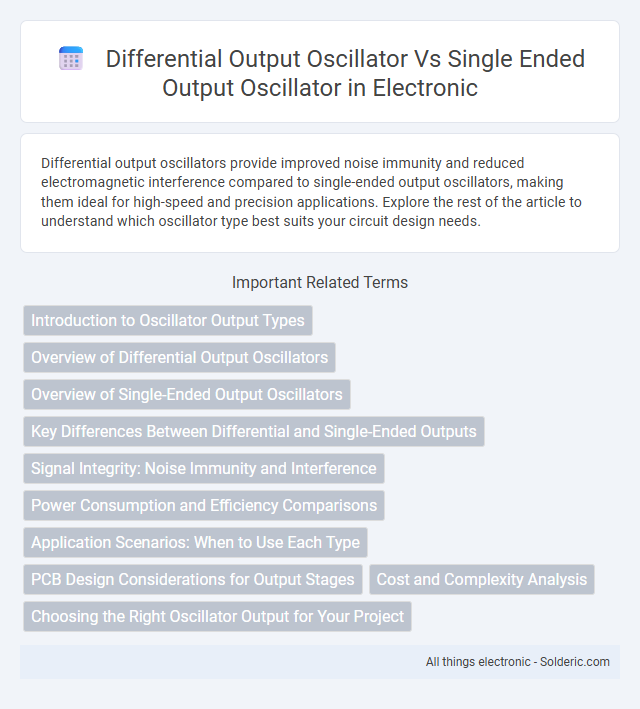Differential output oscillators provide improved noise immunity and reduced electromagnetic interference compared to single-ended output oscillators, making them ideal for high-speed and precision applications. Explore the rest of the article to understand which oscillator type best suits your circuit design needs.
Comparison Table
| Feature | Differential Output Oscillator | Single-Ended Output Oscillator |
|---|---|---|
| Output Type | Two complementary signals (differential) | Single output signal referenced to ground |
| Noise Immunity | High; rejects common-mode noise | Lower; more susceptible to noise |
| Signal Integrity | Better; reduced electromagnetic interference (EMI) | Lower; higher EMI |
| Power Consumption | Typically higher due to balanced outputs | Generally lower power consumption |
| Complexity | More complex circuitry required | Simpler design and implementation |
| Applications | High-speed data communication, RF circuits | Low-power, basic timing applications |
| Output Amplitude | Differential voltage swing (higher effective amplitude) | Single-ended voltage swing (limited amplitude) |
Introduction to Oscillator Output Types
Oscillator output types primarily include differential output oscillators and single-ended output oscillators, each serving distinct signal integrity and noise immunity needs. Differential output oscillators generate two complementary signals, enhancing noise rejection and improving signal integrity in high-speed communication systems. Your choice between these oscillator types depends on the application requirements for noise performance, power consumption, and circuit complexity.
Overview of Differential Output Oscillators
Differential output oscillators generate complementary signals using paired outputs, enhancing noise immunity and minimizing electromagnetic interference compared to single-ended oscillators. They offer improved signal integrity by providing balanced outputs that reduce common-mode noise and enable better suppression of power supply fluctuations. Differential designs are widely used in high-speed communication systems and precision timing applications where signal purity and robustness are critical.
Overview of Single-Ended Output Oscillators
Single-ended output oscillators feature a single output terminal that delivers the oscillating signal relative to ground, making them simpler in design and easier to interface with standard load circuits. These oscillators are commonly used in applications where signal integrity over long distances is not critical, as they are more susceptible to noise and electromagnetic interference compared to differential output oscillators. Single-ended output configurations typically exhibit lower power consumption and reduced circuit complexity, suitable for low-frequency or cost-sensitive applications.
Key Differences Between Differential and Single-Ended Outputs
Differential output oscillators provide two complementary signals that enhance noise immunity and reduce electromagnetic interference, making them ideal for high-speed and high-precision applications. Single-ended output oscillators generate a single signal referenced to ground, simplifying design but offering less noise rejection and potentially more signal distortion. The choice depends on system requirements for signal integrity, power consumption, and layout complexity.
Signal Integrity: Noise Immunity and Interference
Differential output oscillators provide superior noise immunity and signal integrity compared to single-ended output oscillators due to their ability to reject common-mode noise and electromagnetic interference through balanced signal transmission. Single-ended output oscillators are more susceptible to noise and interference because the signal references a common ground, making them vulnerable to ground loops and external noise sources. The differential architecture minimizes signal distortion and enhances overall performance in high-speed and high-frequency applications by maintaining cleaner waveforms and stable output.
Power Consumption and Efficiency Comparisons
Differential output oscillators typically consume more power than single-ended output oscillators due to their dual transistor operation, yet they deliver higher efficiency by providing better noise immunity and signal integrity. Single-ended oscillators draw less current, making them suitable for low-power applications but often at the expense of increased susceptibility to common-mode noise. Efficiency in differential oscillators is enhanced by balanced signal paths, which minimize distortion and power losses, whereas single-ended designs may suffer from higher harmonic distortion affecting overall performance.
Application Scenarios: When to Use Each Type
Differential output oscillators are ideal for high-speed communication systems, RF circuits, and mixed-signal designs requiring noise immunity and reduced electromagnetic interference (EMI). Single-ended output oscillators suit low-frequency applications, simple clock generation, and cost-sensitive designs where noise performance is less critical. You should choose based on the complexity of your system, noise environment, and signal integrity requirements.
PCB Design Considerations for Output Stages
Differential output oscillators offer improved noise immunity and reduced electromagnetic interference (EMI) compared to single-ended output oscillators, making them preferable for sensitive PCB designs. Careful impedance matching and balanced routing are critical for differential pairs to maintain signal integrity, while single-ended outputs require meticulous ground referencing and shielding to minimize crosstalk. PCB layout for differential outputs emphasizes symmetry and controlled trace lengths, whereas single-ended designs focus on minimizing loop area and providing stable return paths to reduce signal degradation.
Cost and Complexity Analysis
Differential output oscillators generally incur higher costs and greater design complexity due to the need for matched components and additional circuitry to maintain signal integrity and balance. Single-ended output oscillators are typically less expensive and simpler to implement, making them suitable for cost-sensitive and straightforward applications. The trade-off involves differential outputs providing better noise immunity and signal quality at the expense of increased power consumption and circuit complexity.
Choosing the Right Oscillator Output for Your Project
Differential output oscillators provide improved noise immunity and signal integrity by transmitting signals through two complementary outputs, making them ideal for high-speed and precision applications. Single-ended output oscillators offer simpler designs and lower power consumption, suitable for less demanding environments where cost and simplicity are priorities. Selecting the right oscillator output depends on project requirements such as noise tolerance, signal quality, PCB layout complexity, and overall system architecture.
Differential output oscillator vs Single ended output oscillator Infographic

 solderic.com
solderic.com